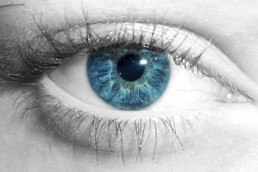What Determines Your Eye Color?
The part of our eye with such striking color is the iris, which is a muscle that controls the size of the pupil in reaction to different light levels. The color of the iris is determined by how much melanin pigmentation we have – the darker your eyes are, the more melanin you have. Van Morrison’s brown-eyed girl has a lot of melanin pigmentation, while Judy Blue Eyes has much lower levels.
There are two separate genes that influence eye color: the OCA2 gene and HERC2 gene. OCA2 produces P protein, which creates melanin. However, this gene is sometimes limited by HERC2, resulting in lighter eye color. Melanin pigmentation does more than just set your eye color, though – it also affects how sensitive your eyes are to light. The more melanin you have (and therefore the darker your eyes are), the less sensitive your eyes are to light.
Brown is by far the most common eye color in the world, with nearly all people of African, Hispanic, or Asian descent having brown eyes. Hazel is the second most common, followed by blue, gray, and green, with amber and even red appearing in very rare cases. However, it’s not uncommon for eyes to change color over a lifespan – most Caucasian babies are born with blue or nearly colorless eyes, which can eventually turn darker within a few years as melanin levels increase, and can even continue to darken later in life.
No matter what color your eyes are, we all see color differently. This is why the accuracy and consistency of Konica Minolta Sensing color measurement products is so important. Handheld spectrophotometers like the CM-26dG or CM-17d by Konica Minolta Sensing accurately measure color samples no matter the lighting or shape of the object. Even if your vision isn’t completely trustworthy, a spectrophotometer from Konica Minolta Sensing always will be.










